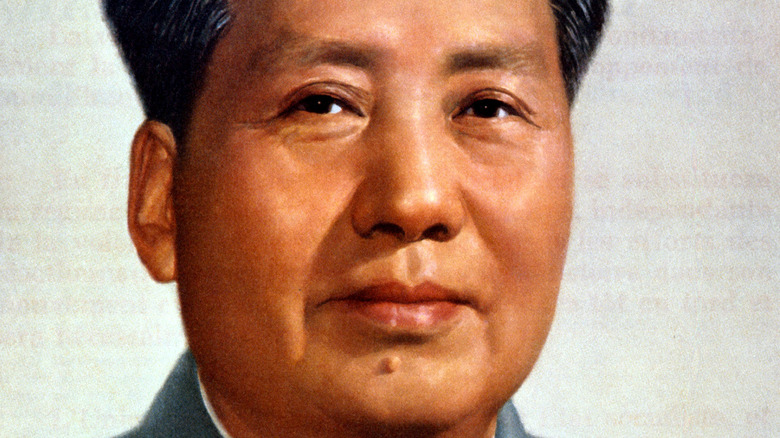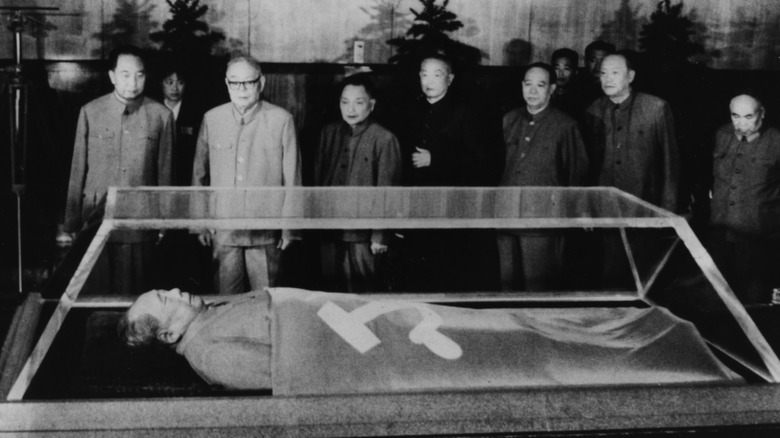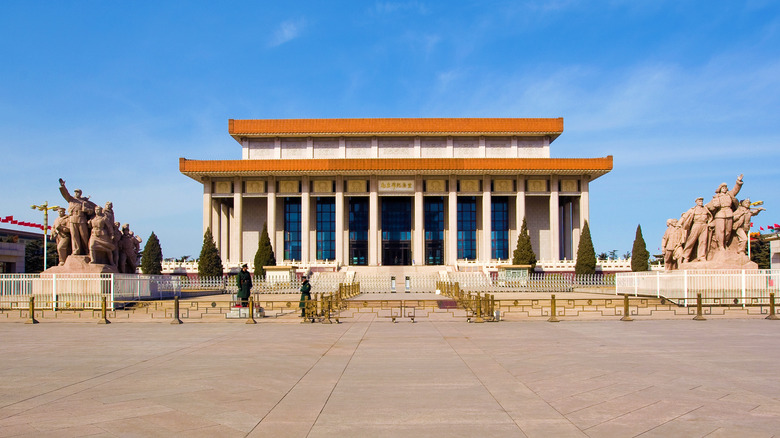Here's What Really Happened To Mao Zedong's Corpse
Born in 1893, Mao Zedong was a communist leader and founder of the People's Republic of China (via BBC). Although revered by many, his legacy is complicated, to say the least. To some, he is a political genius and military mastermind (via Biography). To others, he's a genocidal maniac who caused the deaths of millions and whose efforts to modernize China were tantamount to self-sabotage. In 1958, Britannica explains that Mao unleashed his infamous Great Leap Forward campaign. The goal was to push China's farming society into an industrial civilization within only five years (per Thought. Co). The results were devastating.
The Washington Post states that the Great Leap Forward led to an estimated 45 million deaths and is now considered to be the largest mass murder in history. The publication adds that people were tortured, executed, and starved to death. Thought. Co explains that Mao's campaign destroyed farmland and crops. Additionally, it severely damaged the environment as he pushed for unethical steel manufacturing practices.
On September 9, 1976, Mao died due to complications from Parkinson's disease. According to The Guardian, Mao said he wanted to be cremated, but after his death, his wife chose to have his body displayed publicly. Still, although he was 82, such a figure's death was hard to imagine and there were no preparations in place. His body, per Morning Sun, would now belong to the people of China. But this was easier said than done, and the clock was ticking against the natural process of decay.
Preserving the body was complicated
Initially, Mao Zedong's body had to be cooled down without freezing it (via The Guardian). When Xie Piao, the man tasked with the cooling process was first presented with the body, it was under hot lights in a room temperature setting. Cooling the body was a challenge; technology was finicky, but officials eventually succeeded by using nitrogen gas. Things were so tense that those working on the body didn't sleep for days at a time. Xie stated, "It was very serious, no one chatted." After eight days, the entire process was over.
No official accounts of how Mao was actually preserved have ever been published and Xie admitted that he was not involved in the process. Mao's former doctor Li Zhisui, went on to say that during the embalming Mao's head swelled "like a football" (via The Guardian). Per Morning Sun, the embalmers took too long to work on him, and thus, his body now has obvious signs of decay. However, Britannica explains that the process usually involves draining the blood from the body and replacing it with formaldehyde.
Keeping the body in good condition is an ongoing effort. For example, PBS notes that Russian leader Vladimir Lenin's publicly displayed corpse is re-embalmed every two years in a six-week process. But Mao never intended for his body to be preserved. In fact, Tiananmen Square Tour states that in 1956, Mao signed "A Proposal that all Central Leaders be Cremated after Death," and said, "After people die they shouldn't be allowed to occupy any more space."
You can visit Mao Zedong's body
Nevertheless, The Guardian reports that Mao's body was put on display in 1977 in Tiananmen Square in Beijing, where it can still be found today. According to The Anthrotorian, his body lies in a crystal coffin that is draped with a red flag bearing a hammer and sickle. His hair is defined by gray streaks, and underneath him is a refrigerator. At night, Mao's body is lowered into it. Tiananmen Square Tour writes that his tomb is earthquake proof and the entire room is a "grand villa." Ten years after the corpse went on display, visitors flocked to the mausoleum. Per A 1987 article from The Los Angeles Times, an estimated 30,000 people were visiting his body every day.
Due to Mao's bloody history, some say his body should be taken off display (per The Guardian). In China, however, he is seen as a hero. A 2013 poll done by Chinese state media found that a majority of respondents were in agreement with Mao's policies and decisions, despite their deadly repercussions (via Al Jazeera). The poll asked, "Do you agree that Mao Zedong's achievements outweigh his mistakes?" 85% said yes. Xie, who helped in the preservation process, stated "Although there is controversy, I think that Mao's corpse has been somewhat useful to China over the decades."
The BBC reports that some rulers are preserved to maintain a symbolic illusion of power. Margot Light, from London School of Economics explained "It's not as ghoulish as it might seem, it has a practical purpose for patriotic reasons and to perpetuate a movement."


